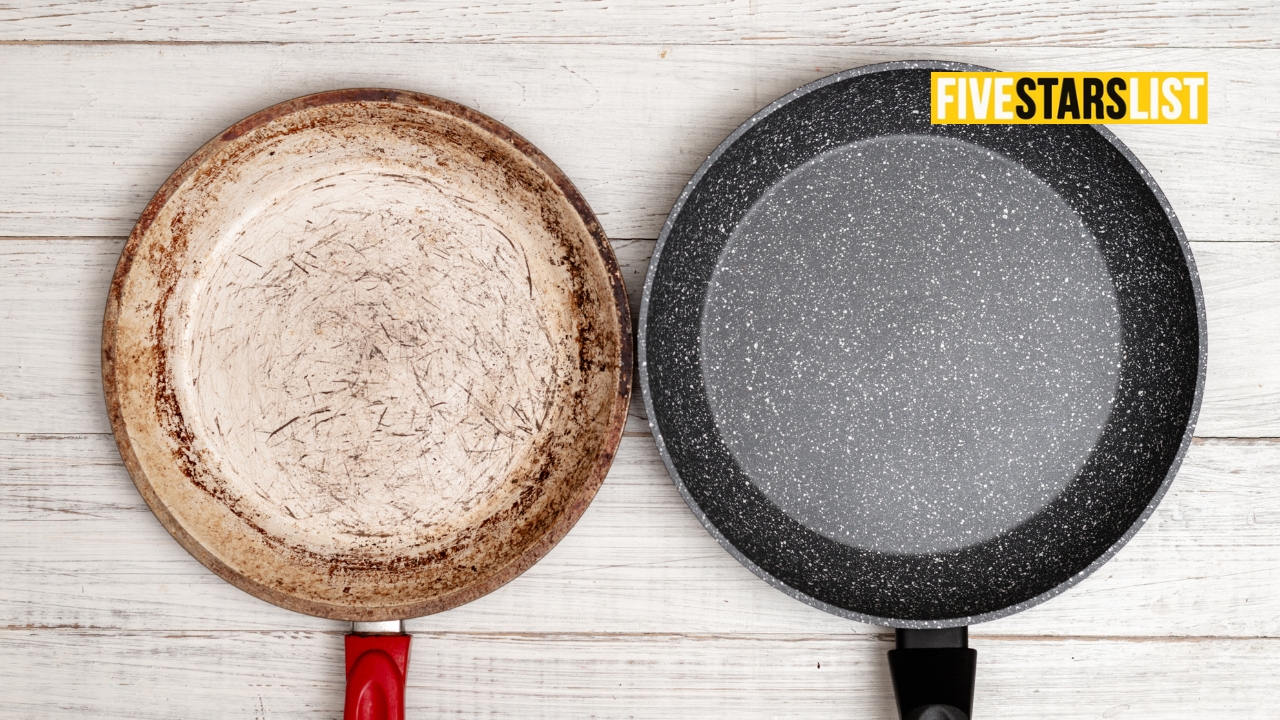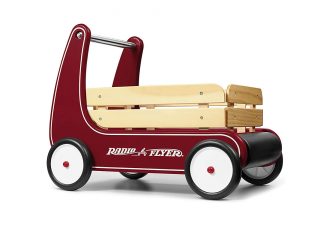As an Amazon Associate I earn from qualifying purchases.

Graphic by fivestarslist.com
A heavy-bottomed pan is more than just a weighty piece of cookware – it’s a fundamental tool that can dramatically improve your cooking results. In this comprehensive guide, we’ll explore everything you need to know about these essential kitchen implements, from their construction and benefits to how to choose and maintain them.
The Anatomy of a Heavy-Bottomed Pan
At its core, a heavy-bottomed pan is distinguished by its thick base, which typically consists of multiple layers of metal. The construction usually involves a combination of materials, with an aluminum or copper core sandwiched between layers of stainless steel. This layered construction, often referred to as “tri-ply” or “multi-ply,” is what gives these pans their characteristic weight and superior cooking properties.
The bottom layer, which comes in contact with the heat source, is designed to conduct heat efficiently. The middle layer, often made of aluminum or copper, serves as an excellent heat conductor and distributor. The top layer, typically stainless steel, provides a durable cooking surface that won’t react with foods.
How to Identify a High-Quality Heavy-Bottomed Pan?
When shopping for a heavy-bottomed pan in person, there are several key indicators of quality to look for:
- Weight Test: Pick up the pan and feel its heft. A truly heavy-bottomed pan should have significant weight, particularly in its base. Compare it with other pans of the same size – the heavier one typically indicates better construction.
- Base Examination: Look at the bottom of the pan. Quality heavy-bottomed pans have a thick, flat base that sits evenly on a flat surface without wobbling. The base should be perfectly level, with no warping or unevenness.
- Material Junction: Check where the sides meet the bottom. In high-quality pans, this junction should be seamless, with no visible gaps or sharp angles that could trap food or cause cleaning difficulties.
- Heat Disc Visibility: Some pans have a visible heat disc on the bottom. If present, it should be firmly attached with no signs of separation from the pan body. The disc should extend fully to the edges of the base.
- Handle Construction: Quality heavy-bottomed pans feature securely riveted or welded handles that feel solid and show no signs of wobbling. The handle attachment area should be reinforced and cleanly finished.
Testing Your Current Pans
To determine if your existing pans have a sufficiently heavy bottom, you can perform several simple tests:
- The Water Test: Pour a small amount of water into the pan and place it on a level burner. Heat the water and observe its movement. In a heavy-bottomed pan, bubbles should form evenly across the bottom surface. If bubbles only form in certain areas, this indicates hot spots and an inadequately heavy bottom.
- The Heat Retention Test: Heat your pan on medium-high for 3 minutes, then remove it from heat. Hold your hand about 6 inches above the pan’s surface. A heavy-bottomed pan should radiate heat evenly for several minutes. If some areas cool faster than others, the bottom may be too thin.
- The Spinning Test: On a flat surface, try spinning your empty pan gently. A heavy-bottomed pan should spin smoothly and evenly, while a warped or thin-bottomed pan will wobble or spin unevenly.
- The Visual Inspection: Turn your pan upside down and examine the bottom. Heavy-bottomed pans typically have a visible layer or disc of additional material. This layer should be firmly attached and extend close to the edges of the base.
Why Weight Matters in Cookware
The substantial weight of these pans isn’t just for show – it serves several crucial functions in the cooking process. The added mass helps maintain consistent temperature, prevents hot spots, and provides better heat distribution throughout the cooking surface. This is particularly important when cooking delicate foods or dishes that require precise temperature control.
When you’re searing meat, for example, a heavy-bottomed pan will maintain its temperature even when cold food is added, ensuring proper browning and caramelization. In contrast, a thin-bottomed pan might cool down significantly when food is added, leading to uneven cooking and potentially steaming rather than searing.
Benefits of Cooking with Heavy-Bottomed Pans
The advantages of using heavy-bottomed pans extend far beyond just even heat distribution. These pans are less likely to warp over time, which is a common problem with lighter, cheaper alternatives. They’re also more resistant to denting and damage, making them a worthwhile long-term investment for any kitchen.
Another significant benefit is their versatility. Heavy-bottomed pans can handle high-heat cooking methods like searing and frying, but they’re equally adept at gentle simmering and sauce-making. The superior heat retention means they’re excellent for maintaining consistent temperatures during long cooking processes.
Temperature Control and Heat Distribution
One of the most significant advantages of heavy-bottomed pans is their superior heat management. The thick base acts as a heat buffer, preventing rapid temperature fluctuations that can lead to burned or unevenly cooked food. This characteristic is particularly valuable when cooking dishes that require precise temperature control, such as delicate sauces or caramel.
The even heat distribution ensures that food cooks uniformly across the entire surface of the pan. This eliminates cold spots where food might cook more slowly and hot spots where it might burn, resulting in more consistent and professional-quality results.
Maintenance and Care
While heavy-bottomed pans represent a significant investment, proper care can ensure they last for generations. Most are dishwasher safe, but hand washing is recommended to maintain their appearance and prevent potential damage to the exterior finish. It’s important to allow these pans to cool naturally rather than shocking them with cold water, which could cause warping despite their sturdy construction.
Regular maintenance might include occasional polishing for copper-bottomed pans or removing stubborn stains from stainless steel surfaces. Many manufacturers recommend using non-abrasive cleaners to preserve the pan’s surface and maintain its non-reactive properties.
Storage Recommendations
Proper storage is crucial for maintaining the quality and longevity of heavy-bottomed pans. When stacking these pans, place protective layers such as paper towels, cloth napkins, or purpose-made pan protectors between each piece to prevent scratching. For pans with non-stick surfaces, this is particularly important as scratches can compromise the coating’s effectiveness.
Consider installing a pot rack or wall-mounted storage system to eliminate the need for stacking altogether. This not only prevents damage but also makes your cookware easily accessible. If cabinet storage is your only option, store pans vertically using dividers or organizers designed specifically for cookware. Avoid sliding pans against each other when removing them from storage, as this can cause scratches and damage to both the cooking surface and exterior finish.
For pans with helper handles or long handles, ensure they are positioned in a way that prevents them from catching on other items or being bent during storage. If possible, store lids separately or use lid organizers to prevent them from damaging the pans’ surfaces.
Top Heavy-Bottomed Pans Available on Amazon
All-Clad D3 Stainless Steel Frying Pan
Calphalon Contemporary Hard-Anodized Pan
Le Creuset Toughened Nonstick Pro Pan
Demeyere Industry 5-Ply Stainless Steel Pan
Mauviel M’Heritage Copper Frying Pan
Conclusion
A heavy-bottomed pan is more than just a cooking vessel – it’s an investment in better cooking results and long-term durability. While these pans may cost more initially, their superior construction, even heat distribution, and lasting durability make them an essential tool for both home cooks and professional chefs. Understanding the benefits and proper care of heavy-bottomed pans can help you make an informed decision when upgrading your cookware collection and ensure you get the most value from your investment.
Whether you’re searing a steak, making a delicate sauce, or simply preparing everyday meals, a heavy-bottomed pan will provide the consistent, reliable performance that can elevate your cooking from good to exceptional. By choosing quality cookware and maintaining it properly, you’re not just buying a pan – you’re investing in better cooking results for years to come.
Image source: Amazon Product Advertising API
Amazon and the Amazon logo are trademarks of Amazon.com, Inc, or its affiliates.
Last update on 2025-04-18 / Affiliate links / Images from Amazon Product Advertising API








